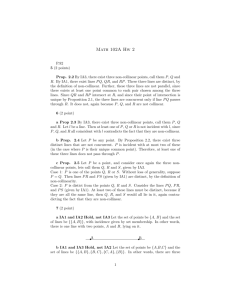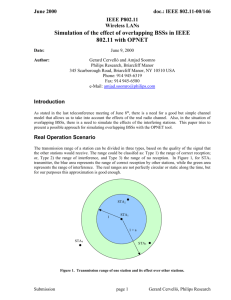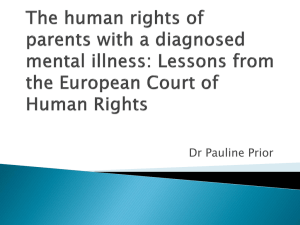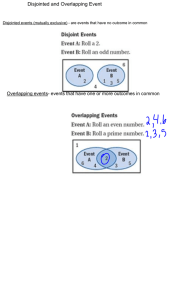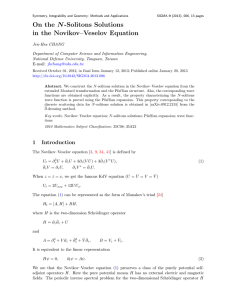Simulation Results - City University of Hong Kong
advertisement
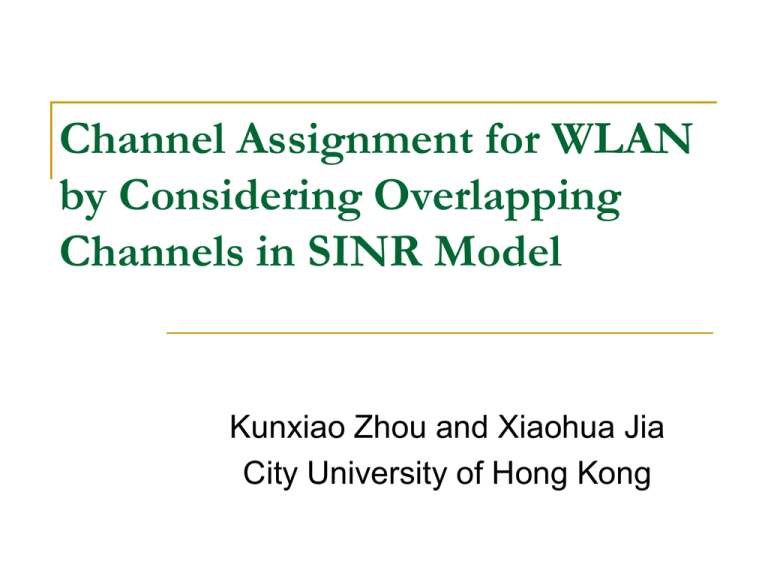
Channel Assignment for WLAN
by Considering Overlapping
Channels in SINR Model
Kunxiao Zhou and Xiaohua Jia
City University of Hong Kong
Outlines
Introduction
Related work
Problem formulation
Proposed solution
Simulation results
Conclusion
2
Introduction
Channel assignment
Partially overlapping channels (802.11b)
Wireless Local Area Networks (WLANs)
Access points (APs), clients
Basic service set (BSS)
Assign channels to BSSs
11 partially overlapping channels
3 non-overlapping (orthogonal) channels
SINR model
Accumulative nature of interference
Most of combinatorial optimization techniques based
on protocol model are not applicable
3
Related work
A. Mishra, V. Shrivastava, S. Banerjee, and W. Arbaugh,
“Partially overlapped channels not considered harmful,”
SIGMetrics/Performance, 2006, pp. 63–74.
Y. Cui, W. Li, and X. Cheng, “Partially overlapping
channel assignment based on “node orthogonality” for
802.11 wireless networks,” Mini-Conference at IEEE
INFOCOM, 2011.
Interference of overlapping channels
Communication btwn two nodes by using overlapping channels
interference model: two nodes interfering or not depends on channel
distance and physical distance bwtn two nodes (i.e. “node orthogonality”)
A. Mishra, S. Banerjee, and W. Arbaugh, “Weighted
coloring based channel assignment for wlans”, in ACM
Sigmobile MC2R, 2005
ADJ-minmax and ADJ-sum
4
Problem Formulation
Infrastructure-based IEEE 802.11 WLAN,
BSS1
BSS2
u3
A1
A2
u2
u4
u1
u9
u7
u5
u10
A3
u6
BSS3
A4
u8
BSS4
5
Problem Formulation (cont’d)
W= {w1,…,wm}: set of APs; U= {u1,…, un}: set of clients;
F= {f1, f2, … , fk}: set of overlapping channels;
BSS: AP and its associated clients
G(U ∪ W, E) , (u, w) ∈ E: client u connects to AP w;
γ(v,u): overlapping degree btwn channels of node v and u.
Pd (w, u)
SINRu
.............(1)
N P (v, u)d (v, u)
vW ,v u
Channel overlapping degree:
6
Problem Formulation (cont’d)
Ru Q log2 (1 10log SINRu )
Data rate:
The throughput of a BSS : TB
w
R
uS ( w )
u
Throughput of the system:
T
T
wW
Bw
R R
wW uS ( w )
u
uU
u
Pd ( w, u )
Q log2 (1 10 log
), u S ( w)
uU
P (v, u )d (v, u )
vW ,v w
7
Problem Formulation (cont’d)
Total interference of u received from all APs:
Iu
(
v
,
u
)
d
(
v
,
u
)
, u S (w)
vW ,v w
Total interference of all clients in the system:
I
(
v
,
u
)
d
(
v
,
u
)
uU vW ,u S ( v )
Maximize the system throughput is equivalent to
minimizing system total interference
8
Algorithm Design
Interference analysis:
Interference caused by AP v to client u (u
S(v))
iv,u (v, u)d (v, u) , u S (v)
Interference
iv, Bw
We
by AP v to all clients in a BSS Bw,
iv,u (v, u)d (v, u)
uS ( w),v w
uS ( w),v w
only consider downlink case,
i(Bv , Bw ) iv, Bw
9
Algorithm Design (cont’d)
Fig. 2, weighted interference graph GI(VI,EI)
iA1,u3+iA1,u4
BSS1
BSS2
iA
iA2,u1+iA2,u2
4,u
1
iA
+
5
u
,
i A2
3+
u
,
i A3
,u7
2
A
i
iA
1 ,u
8+
iA
1 ,u
9+
iA4,u3+iA4,u4
+
6
2,u
,u4
3
A
i
2
iA2,u8+iA2,u9+iA2,u10
A4
,u
iA3,u1+iA3,u2
iA1,u5+iA1,u6+iA1,u7
+i
iA
iA4,u5+iA4,u6+iA4,u7 1,u10
BSS3
BSS4
iA3,u8+iA3,u9+iA3,u10
10
Algorithm Design (cont’d)
Total weights of all edges in GI(VI,EI) ,
TI
i i( B , B
eE I
e
uW vW ,v w
v
w
)
( v, u ) d ( v, u )
wW vW ,v w uS ( w )
(
v
,
u
)
d
(
v
,
u
)
uU vW ,uS ( v )
The total weight of all edges in GI is equal to the total
interference of the system.
Our problem is converted to minimizing the total weight of all
edges in GI(VI,EI)
11
Algorithm Design (cont’d)
Heuristic method
12
Simulation Results (throughput)
13
Simulation Results (service ratio)
14
Simulation Results
(per-user throughput)
15
Simulation Results
(channel utilization)
16
Conclusions
Studied channel assignment by considering
partially overlapping channels in SINR model;
Converted the maximal throughput problem
to minimizing total edge weight of the
interference graph;
Proposed a heuristic method;
Channel overlapping attenuation coefficient
is a major factor to affect the channel
utilization.
17
Thanks!
Q&A
18
